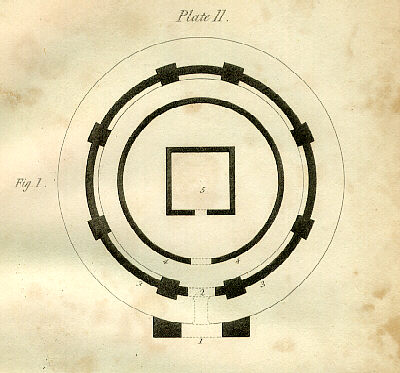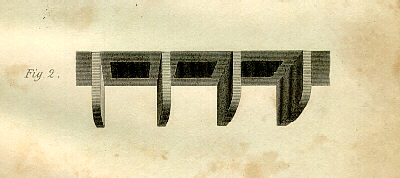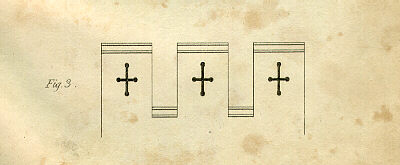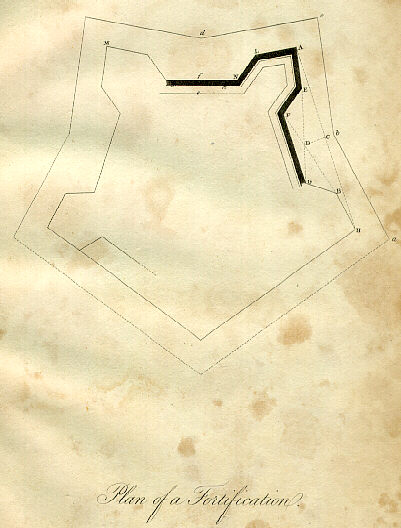| |
SECTION IV
Of Fortifications
Fortified castles owe their origin principally to the feudal times. The peculiarities of structure will appear from the following enumeration of their principal parts.

1. The building first approached was called the Sentinel House or Barbican, standing on the outside of the moat or ditch, over which was the drawbridge, which was raised or let down by mean of balances, called plyers, consisting of two timber levers, about twice the length of the bridge, joined by other timbers framed like a cross to act as a counterpoise. These swing on two upright pieces, and the bridge is raised or lowered by chains which join the ends of the plyers and the bridge.
2. The entrance to the Ballium, which was through a strong machicolated and embattled gate, between two towers, the machicolations or holes at the head of the gate, through which melted lead and scalding water were poured down, and large stones thrown upon the heads of the assailants, as they attempted to force an entrance, are shown in Fig. 2:

the gate was also secured by a herse or portcullis, (portecoulisse), consisting of several large pieces of wood, crossed like a barrow, having the bottom ends pointed with iron; this was let down when the enemy came by surprise, so quickly, as not to allow time for shutting the gates.
3. The walls of the outer Ballium or outworks; these were usually of a circular form, very high, with an embattled parapet, consisting of crenelles and merlons pierced with oillets or loop holes, Fig 3;

there were steps for mounting the wall, and towers for its better defence at stated distances.
4. The wall of the inner Ballium, which was not so strongly fortified, and without towers.
5. The Keep or Dungeon, which stood on an eminence in the centre, where the besieged fled as a last resource; its walls were very strong; it had a well within it for a supply of water, and frequently, a subterraneous passage, which conducted to the outworks, for a means of escape, when the want of provisions or other circumstances rendered it impossible for the besieged to offer further resistance. When the Keep was of a circular form, it was then called a Julliet. In large works of this kind there were also wards and dungeons for the prisoners, extending under ground, sometimes as far as the wall of the inner Ballium.
Fortifications are works constructed for the defence of towns against the attacks of an assailing army. They are either regular or irregular. When built in the form of a regular polygon, with equal sides and angles, (distant about a musket shot from each other), they are called regular; when their sides and angles are unequal, then they are irregular.
Regular Fortifications are composed of the following parts in particular.

Bastion, FEALN.
Faces of the Bastion, ALAE.
Flanks of the Bastion, EFLN.
Curtain, FG.
Gorge of the Bastion, FN.
Lines of defence, AG, FH.
Exterior side of the Polygon, AH.
Perpendicular, CD.
Counterscarp of the Ditch, abcd.
Flanked Angles, AM.
Shoulder, BEL.
Angles of the Flank, FGN.
Rampart, ef.
Parapet, g.
Banquette or Step, h.
All works constructed beyond the ditch, before the body of the place, are called outworks.
All works have a parapet three toises thick, and a rampart from eight to ten. The rampart is generally elevated from ten to twenty feet, according to the nature of the place; the banquette is two or three feet higher than the rampart; and the parapet five or six above the banquette. The length of the parapet depends upon the number of guns to be employed in the battery; for one gun eight yards is generally allowed, and six yards for every additional gun. The parapet of the wall is constructed of stone or brick, but the parapet of the trenches is formed of earth thrown up, fascines, (which are branches of trees and sticks bound up in bundles), barrels, or the like. Ramparts are also surrounded by a revetement or strong wall.
| |
Appareille, the slope or easy ascent leading to the platform of the bastion.
Arrow, a work at the salient angle of the glacis.
Berme, the small space of flat ground left between the rampart and the scarp of the ditch, generally five or six feet wide.
Bonnet, a work with two faces to cover a ravelin.
Branche, a word applied to the extended sides of the different works, as the covert-way, ditch, etc.
Bray, a false trench to conceal a real one.
Cascans, cylindrical shafts or holes, serving as entrances to galleries, or to give vent to an enemy's mine.
Casemate, a work under the rampart with loop holes for the guns.
Cavalier, a work in the body of a fortified place, raised ten or fifteen feet above the surrounding ones.
Cordon, a line of stone entirely round a fortification, jutting out between the rampart and base of the parapet.
Covert-way, a space of five or six toises broad, extending round the counterscarp.
Cremaille, the inside line of a parapet, formed so as to resemble the teeth of a saw.
Crown works, those resembling a crown in form, with two fronts and two branches.
Cuvette, a small ditch in the middle of a dry ditch.
Esplanade, the declivity or slope from the top of the counterscarp to the level of the plain: it is also used to signify the void space between the glacis of a citadel, and the first houses of a town.
Facing, the masonry used on the bases of ramparts to preserve them from injury and the danger of falling.
Flêche, a work with two faces, constructed before the glacis.
Fort, a strong hold of small extent; a royal fort, one whose line of defence extends twenty-six fathoms or more; star fort, a redoubt with re-entering and salient angles.
Gabionnade, a bulwark made with gabions, which are baskets five or six feet high, filled with earth, and placed upon the batteries for covering the men.
Gallery, a covered walk across the ditch of a besieged town.
Gazons, sods, or pieces of fresh turf, cut in the form of a wedge, and employed for lining the parapets and traverses of galleries.
Glacis, the part beyond the covert way, to which it serves as a parapets.
Guerite, a sentry box or small tower, placed on the point of a bastion, for a sentinel to guard the ditch against surprise.
Horn works, those having one front and two branches.
Lunettes, works constructed on both sides of a ravelin.
Moineau, a flat bastion raised before a curtain when it is too long, and the bastions of the angles too far distant to defend each other. Here musqueteers are usually placed to fire each way.
Orillon, that part of the bastion near the shoulder, which serves to cover the retired flank from being seen obliquely.
Outworks, and other small works of any kind are often surrounded by the chevaux de frise, a piece of timber laid horizontally, and traversed with wooden spikes pointed with iron, which is intended to defend a passage, or form a retrenchment against cavalry: a cheval de frise planted in a gap or breach is named a herisson or turnpike.
Palisades, enclosures of stakes, about nine or ten feet in length, driven into the ground at about six or eight inches asunder, and strongly braced together; when used as a work, this is called a tambour. These palisades are used to fortify or secure the covert ways, avenues of open forts, the bottom of ditches, and all fortified posts liable to surprise, and easy of access.
Pate, a species of platform like a horse shoe in form, encompassed with a parapet; it is generally erected to cover the gate of a town.
Ramps, gentle slopes made for the cannon to be drawn up and down, and for the accommodation of the troops posted in a battery.
Ravelins, works placed before, to cover the curtain.
Redoubt, a work beyond the glacis of various forms.
Re-entering angle, that which has its vertex turned inwards towards the work.
Saigner, to empty the water out of a moat, by channels under ground, so that it may be easily passed, after having laid down clayes, hurdles, or the like.
Salient angle, that which has its vertex projecting outwards from the work.
Sap, a deep trench cut to make a passage into a covert way; a single sap has only one parapet, a double sap has one on each side.
Scarp, the sloping side of the ditch looking towards the field.
Sconce, a small fort erected for the defence of a narrow ford in a river.
Sillon, a work raised in the middle of a ditch, for a better defence when it is very wide.
Spurs, walls built across a rampart to join it to the walls of a town.
Subterraneous works and mines are also constructed for trains of gunpowder to be laid, in order to blow up the fortified works above them. Several other artifices for defence, of less importance, are often resorted to, according to the situation of the place and other existing circumstances.
Talus, any slope, mostly of use on the inside or outside of any work.
Tenailles, low works in the ditch before the curtain.
Terreplain, the platform or horizontal surface of a rampart.
Traverse, a trench with a small parapet, which is made by the besieged across the moat of a place.
Trenches, approaches or lines of approach, ditches made by the besiegers that they may approach more securely to the place attacked; counter trenches are those made by the besieged against the others.
Vestibule, the area or enclosed courtyard in the front of guard-house.
| |
|